Zundert
Zundert (Dutch pronunciation: [ˈzʏndərt] (![]()
Zundert | |
|---|---|
 Zundert city hall in 2010 | |
 Flag  Coat of arms | |
.svg.png) Location in North Brabant | |
| Coordinates: 51°28′N 4°40′E | |
| Country | Netherlands |
| Province | North Brabant |
| Government | |
| • Body | Municipal council |
| • Mayor | Leny Poppe-de Looff (CDA) |
| Area | |
| • Total | 121.17 km2 (46.78 sq mi) |
| • Land | 120.78 km2 (46.63 sq mi) |
| • Water | 0.39 km2 (0.15 sq mi) |
| Elevation | 12 m (39 ft) |
| Population (January 2019)[4] | |
| • Total | 21,612 |
| • Density | 179/km2 (460/sq mi) |
| Demonym(s) | Zundertenaar, Zundernaar |
| Time zone | UTC+1 (CET) |
| • Summer (DST) | UTC+2 (CEST) |
| Postcode | 4880–4891 |
| Area code | 076 |
| Website | www |
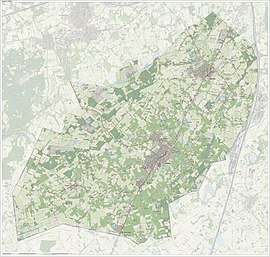
History
The origin of the town of Zundert is like that of many others, very unclear. The name is first encountered in a certificate dating from 1157, in which the Bishop of Liege, confirms a donation from the place "Sunderda". This Sunderda actually relates to the current settlement of Klein-Zundert (Dutch for Small Zundert), one of the first settlements in the area. The local monks, besides their religious labour, were also involved in clearing the land, that was still rough territory, filled with swamps, peats and heath fields. The monks also assisted in improving agricultural methods.
Zundert is still surrounded by a rural environment with nature areas, one of them is the "Buissche Heide", a heath area used for recreation and walking. The Kalmthoutse Heide, across the border with Belgium, is also in the vicinity.
During the Second World War Zundert, Achtmaal, Wernhout and Klein-Zundert were liberated during the allied offensive Operation Pheasant on October 27, Rijsbergen on October 28. Achtmaal was liberated by the 415th Infantry Regiment of the US 104th (Timberwolf) Infantry Division, Zundert and Klein-Zundert by the 413th Infantry Regiment of the 104th (Timberwolf) Infantry Division, and Wernhout and Rijsbergen by the 414th Infantry Regiment of the 104th (Timberwolf) Infantry Division.
At a small distance from the town, an old tavern called "In Den Anker" can be found, which has the oldest license in the Netherlands. It originally dates from 1635, but was rebuilt in 1913.
Geography
The municipality of Zundert contains the following places:
- Zundert (town)
- Rijsbergen
- Klein-Zundert
- Wernhout
- Achtmaal
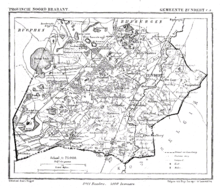
Zundert lies about 12 metres (39 ft) above Dutch sea level (NAP), and is located 15 kilometres (9.3 mi) south-west of the city of Breda, and 35 kilometres (22 mi) north-east of Antwerp, Belgium. Zundert is surrounded by the municipalities Etten-Leur and Breda on the north, Hoogstraten (Belgium) on the east, Wuustwezel (Belgium) on the south, Kalmthout (Belgium) on the southwest, and Essen (Belgium) and Rucphen on the west.
Zundert is one of the most agricultural municipalities of the Netherlands. 10% of all nursery production of the Netherlands is around Zundert. Production of strawberries and young field grown trees and hedging plants is very important in the area.
Architecture
The Roman Catholic church of Zundert, dedicated to Saint Trudo, was built in 1927, and contains art treasures from the 17th century, coming from the St. Michielsabdij in Antwerp. These treasures consist of marble altar tables, three Alabaster sculptures, several paintings and two carved oaken confessionals. The church itself was designed by Jan Stuyt, a pupil of the architect Pierre Cuypers. Stuyt also designed the church of nearby Klein-Zundert in the same municipality.
The town hall of Zundert was built in 1830 in neoclassical style and demolished and rebuilt in the same style in 1965.
Windmills
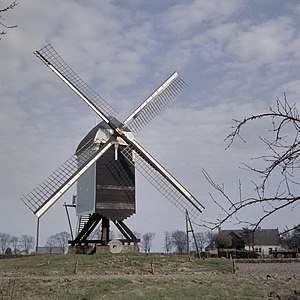
Zundert is the home of a 17th-century windmill, called 'De Akkermolen' (The Croftmill). It is said to have been originally built in 1652. It is a standard mill, and it was built to process grain.
The mill had numerous private owners in the past, including stadtholder Willem V, as the Baron of Breda, who became owner in 1794. In the early 1900s the mill was owned by Wilhelmus van der Stappen.
The mill was heavily damaged in 1950, and its existence was threatened several occasions after that. The Akkermolen is currently owned by the municipality of Zundert, which bought it in 1959, the last private owners being the Herijgers family. After the mill was taken over by Zundert, it needed serious restoration, which took place in 1961. Another restoration took place in 1991, but then, the entire mill needed to be taken apart and restored.
The Akkermolen can be visited, after arranging an appointment at Akkermolenweg 15.
The town had other mills in the past, one of them was a stone-mill called "De Eendracht", which stood on Moleneind, currently known as Poteind. It burned down on January 23, 1909. The owner at the time;Jaak Theeuwis, had already lost a wooden mill in Zundert, which was blown down in the previous year of 1908. A store called "de Boerenbond" is now located on the former mills location.
Vincent van Gogh
Zundert is the birthplace and childhood home of the famous painter Vincent van Gogh.[5] He was born on 30 March 1853 in a little house on Zundert's main street, "Markt 29". The former house is gone as it was too dilapidated to preserve, but a plaque at this location still commemorates his birth. In May 2007 the renovation of the house at Markt 29, and the neighbouring house, started. After the renovation, the Vincent van Gogh house was opened in August 2008.
People can still visit the Dutch Reformed church built in 1806 in which the father of Vincent, Theodorus van Gogh, started preaching in 1849. In the graveyard is the grave of Vincent's one year older brother, who died soon in infancy - also called Vincent van Gogh. Vincent did not paint when he lived in Zundert, but drew some sketches. In letters to his Brother Theo, Vincent recalls Zundert, and its surroundings a few times when writing about childhood, serenity and learning about life. Because he died in the French town of Auvers-sur-Oise, on 29 July 1890, a special relation between these two places exists. This can, for example, be noticed by the existence of a slightly hidden Auvers-sur-Oise Street, ending at the Van Gogh Square.
To keep Vincent's memory alive, the municipality of Zundert started the project of realising a Vincent van Gogh house. Rather than a classical museum, it is an active environment, with a presentation about van Gogh's life, interactive education, a documentation room and also permanent and temporary expositions. Tourist information is also located in the building, as well as a pleasant bar with a garden terrace.
There is a bronze monument made by the French artist Ossip Zadkine of Vincent and his brother Theo on the "Vincent van Gogh Plein" (Vincent van Gogh square). The statue of Vincent and Theo van Gogh was unveiled on 28 May 1964 by the former Dutch queen Juliana. The statue is an abstracted representation of Vincent's connection with his brother Theo.
There are several activities relating to Vincent van Gogh, you can go to tourist information Zundert about participating in these activities, which is in the Vincent van Gogh house, opposite the town hall.
Flower parade
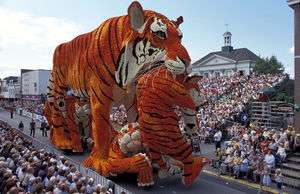
Bloemencorso Zundert is the oldest (since 1936) and hugely elaborate flower parade in Europe, held on first Sunday in September. It is the largest flower parade in the world. Depending on the weather, at least 50.000 people attend. Huge, and often impressive lorry mounted sculptures covered in thousands of dahlia flowers parade through the town. There are twenty hamlets competing in Bloemencorso Zundert and each of them construct their own entry.
Notable people
.jpg)
As well as Vincent van Gogh and family members, Zundert has been home to:
- Hendrik Detmers (1761 in Groot-Zundert – 1825) a Dutch general in the Battle of Waterloo
- Janus Braspennincx (1903 in Zundert – 1977) racing cyclist, team silver medallist in the 1928 Summer Olympics
- Johan van der Velde (born 1956 in Rijsbergen) former Dutch cyclist
- Jacques Hanegraaf (born 1960 in Rijsbergen) retired road bicycle racer, competed at the 1980 Summer Olympics
- Jelle Nijdam (born 1963 in Rijsbergen) former professional cyclist, competed at the 1984 Summer Olympics
- Jacco Verhaeren (born 1969 in Rijsbergen) swimming coach
Gallery
- Sint-Trudokerk, Zundert
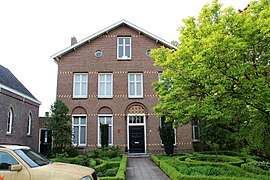 Pastorie, Klein-Zundert
Pastorie, Klein-Zundert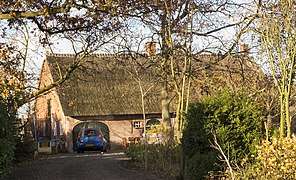 Breedschotsestraat, Rijsbergen
Breedschotsestraat, Rijsbergen Aa of Weerijs bij Krabbenbosschen
Aa of Weerijs bij Krabbenbosschen
References
- "College van B&W" [Board of mayor and aldermen] (in Dutch). Gemeente Zundert. Retrieved 9 June 2014.
- "Kerncijfers wijken en buurten" [Key figures for neighbourhoods]. CBS Statline (in Dutch). CBS. 2 July 2013. Retrieved 12 March 2014.
- "Postcodetool for 4881CN". Actueel Hoogtebestand Nederland (in Dutch). Het Waterschapshuis. Retrieved 9 June 2014.
- "Bevolkingsontwikkeling; regio per maand" [Population growth; regions per month]. CBS Statline (in Dutch). CBS. 1 January 2019. Retrieved 1 January 2019.
- "Home - Van Gogh Brabant". Van Gogh Brabant.
External links

- Official website
